He knew the schedule and would keep an eye on the clock. Most days, if he wasn’t busy with a customer, and if the weather wasn’t something to be avoided, he would step out of the lumberyard’s office just before the appointed time and walk the half block over to the depot to watch her roar by.
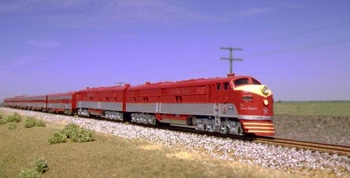
My grandfather didn’t bother with the long freights or the other passenger trains that rumbled along past the picnic grounds and the pond where the trains had once stopped for water, past the station agent’s little office in the Leonard depot where the telegrapher’s Morse key resonated against the empty Prince Albert Tobacco tin. The only train that brought him out was The Texas Special—the high varnish of the Missouri-Kansas-Texas Railway.
In a very special way, it was his train. In time, when I would visit in the summer and spend the day at the lumberyard, climbing in the lofts and digging in the dunes of the big concrete sand and gravel bins, I too would wait for the red and white streamliner with the long string of silver cars filled with people going to places far away. I’d stand alongside the track and wave at the engineer, who would always wave back.
For me, like my grandfather, the train was a magic carpet worth of Aladdin. I rode it once. It was in the early '50s when, with my grandparents, we caught the train in Denison and rode a coach car through the night to St. Louis, where we changed to the Alton’s Ann Rutledge for the trip to Illinois to spend Thanksgiving with my uncle. At least I think we road The Texas Special. It might have been the Flyer, or the Limited, but I just can’t imagine my grandfather taking any train but his favorite.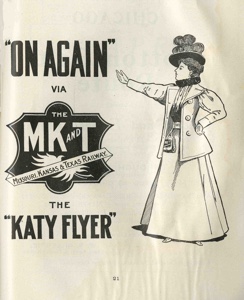
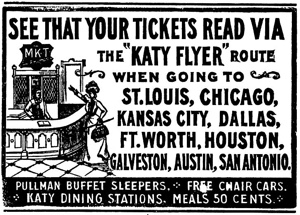
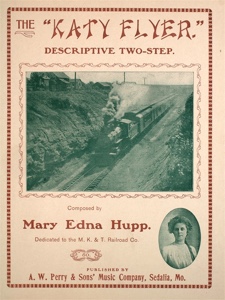
It was soon joined by The Bluebonnet and The Katy Limited. In the 1920s The Limited often pulled six sleepers to San Antonio, a city the line was touting as “The Winter Playground of America.” But through it all, when the pride of the road was reflected in the gleaming brass and immaculate shine on the silver in the dining car Sam Houston, The Texas Special was number one.
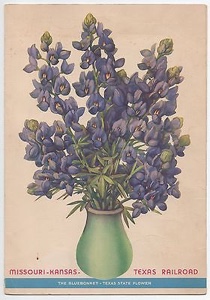
In 1948, the Katy introduced a new, “Flagship of the Southwest.” It was a bright red and white streamliner with The Texas Special name emblazoned under the number boards and on the observation car drumhead, and a white Lone Star centered under the headlamp, this was the train my grandfather watched for each day. 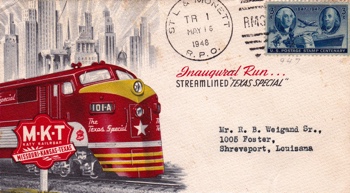

The engine was an ALCO PA-1, and cure any hunger pangs, you could dine is style on the thirty-six seat diner, Sam Houston or the Alexander Doniphan. Once seated you could try two of the Katy’s signature offerings, the Katy Kornettes, silver dollar-sized cornbread rounds or the Katy Special Onion Soup, introduced to highlight the onion growing industry. Recipes for both of these specialities follow at the end of the article.
The trains also offered a light buffet in the rear observation cars, Stephen F. Austin and Joseph Pulitzer. For a more mellow libation, or to visit with fellow travelers, the Mirabeau B. Lamar, or the Temple lounge cars awaited your order.
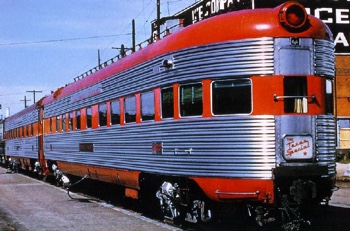
In 1954, Lionel added a Texas Special to their catalogue. The five-foot miniature with the figures of travelers silhouetted against the lighted windows of the passenger cars made many a trip around tall green Christmas trees with would be engineers at the controls.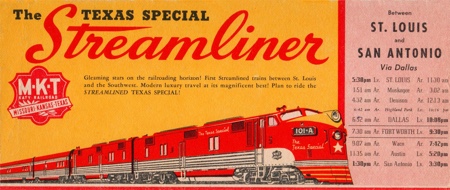
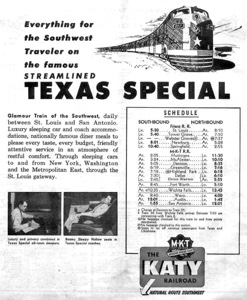
The growing numbers of automobiles in post-war America, significant improvements in the nation highway systems, and the increased competition from the airline industry, presaged a gradual decline in passenger service starting in the late 1940s and continuing into the ’50s and ’60s. The Bluebonnet, the only train in the U.S. named for a wildflower ceased operations in 1948 when The Katy Flyer gave up its sleeping cars, becoming coach service only, then lost its name that same year when The Texas Special entered the streamlined era.
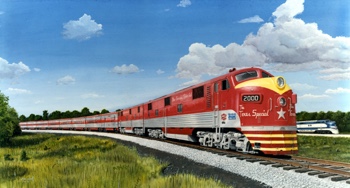
The Katy ended passenger service in 1965 and Katy Limited and legendary Texas Special that passed daily through Leonard, it disappeared around a curve, over a rise and into memory.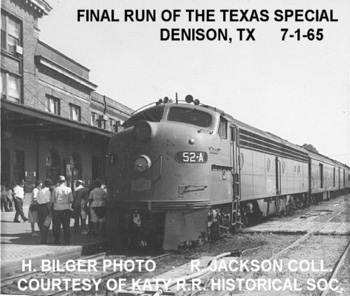
*****
Katy Kornettes
Equipment:
1 1-quart sauce pan
Large mixing bowl
Pastry bag (optional)
2 large cookie sheets
Heat oven to 400º
Ingredients: Yields 48 cakes
1 quart boiling canned sweet milk
1 pound white cornmeal
4 ounces butter, softened
1 tablespoon sugar
1 teaspoon salt
Lightly grease two cookie sheets and set aside. Bring milk to boil and pour into mixing bowl. Stirring constantly, add cornmeal, butter, sugar, and salt and mix well. Let stand for 5 minutes. Using a pastry bag or tablespoon, drop silver-dollar-sized quantities onto the cookie sheets. Cool at room temperature for 15 minutes, then place in oven for about 20 minutes, until cooked–through.
Katy Special Onion Soup
Equipment:
Large skillet
6-quart pot
Ingredients: Yields 8 servings
6 large sweet onions in 1/8 inch dice
4 ounces butter
4 quarts rich chicken stock
4 sprigs parsley
1 clove garlic
2 bay leaves
¼ cup Worcestershire sauce
Soup croutons
Parmesan cheese, freshly grated
Slice onions into 1/8-inch dice. In the large skillet over medium heat, sauté onions in butter until light brown. Meanwhile, heat chicken stock in pot. Add sautéed onions to stock. Add parsley, garlic, bay leaves, and Worcestershire sauce. Bring to boil, reduce heat, and simmer for 20 minutes. Remove parsley, bay leaves, and garlic. Place croutons in serving bowl, pour soup over, and top with a generous portion of freshly grated Parmesan cheese.